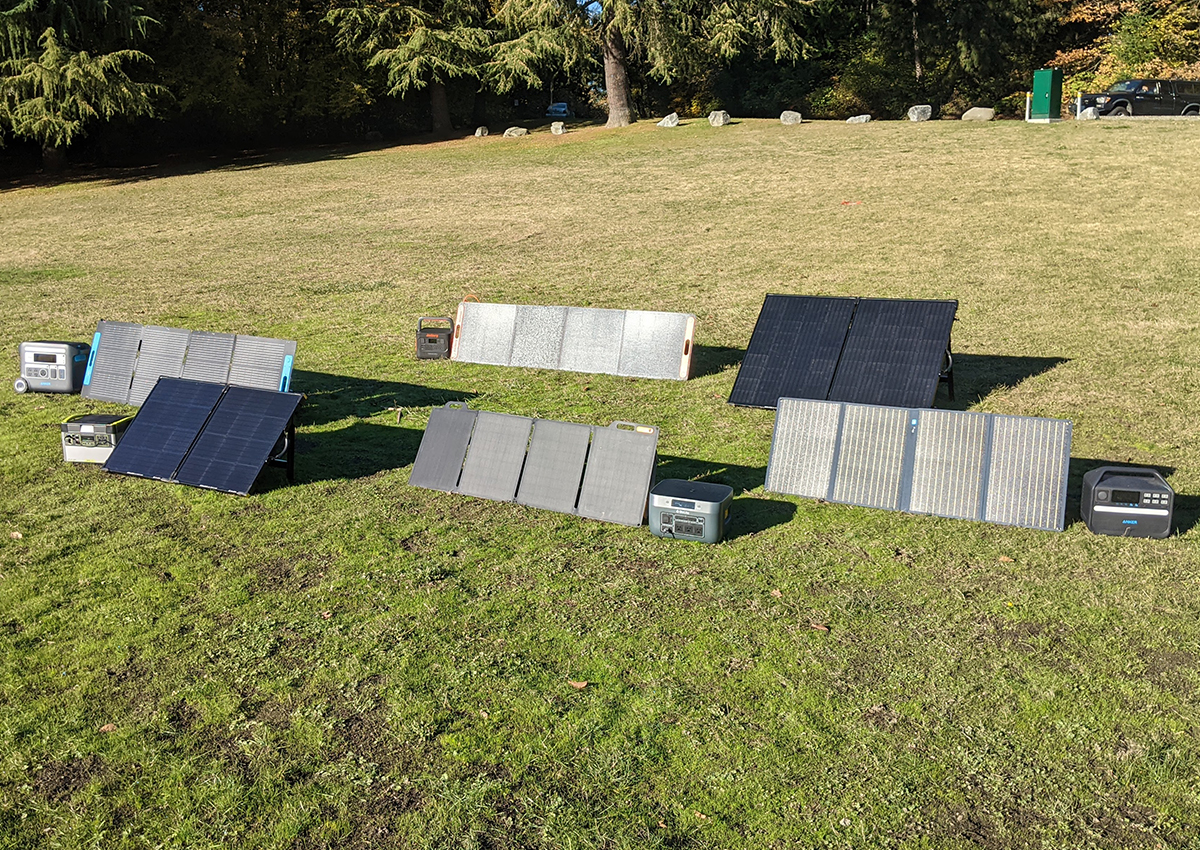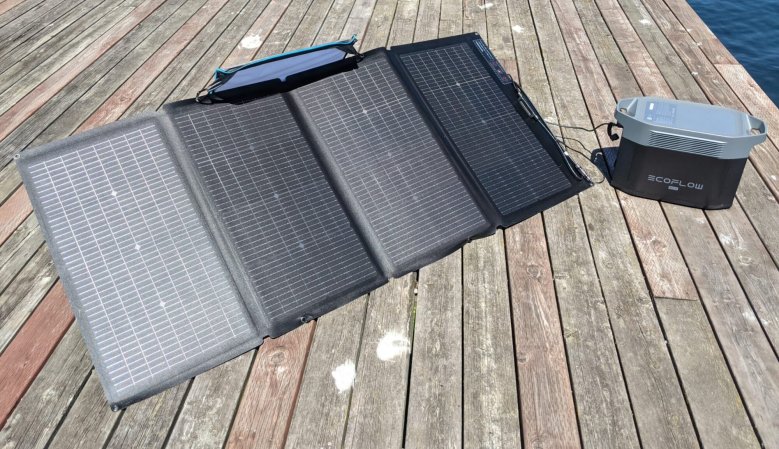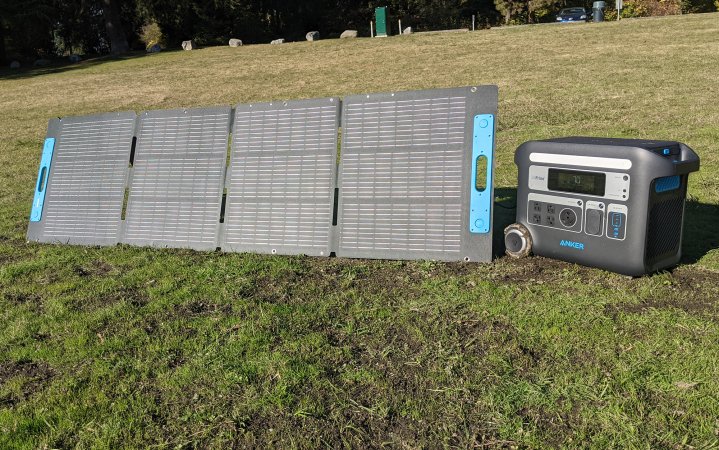Best Solar Generators of 2024, Tested and Reviewed

We may earn revenue from the products available on this page and participate in affiliate programs. Learn More ›
Whether you are outfitting your home in case of an extended power outage or looking for a steady supply of off-grid power for your overlanding setup, it’s never been a better time to purchase a solar generator. But sifting through all the available options on the market — power stations that are lunchbox-sized to luggage-sized, solar panels that can pack in a backpack to multiple eight-foot long panels you chain together — can take a lot of time and effort. To help you choose the best solar generator for your purpose, we tested some of the most innovative models from Jackery, EcoFlow, Goal Zero, Bluetti, Anker, BioLite, Lion Energy, Ugreen, Vtoman, and more to see how they stacked up.
Best Solar Generator for Home Backup: Jackery Solar Generator 2000 Plus
↓ Jump to Review
Best Solar Generator for Off-Grid Living: EcoFlow Delta 2 Max + 220W Solar Panel
↓ Jump to Review
Best Solar Generator for RVs: Anker SOLIX F2000 Solar Generator
↓ Jump to Review
Best Solar Generator for Camping: Bluetti AC60 + Bluetti PV120 Solar Panel
↓ Jump to Review
Best Portable Solar Generator: Anker SOLIX C1000 Solar Generator
↓ Jump to Review
↓ Jump to The Rest of the Field
↓ Jump to Testing Results for Recommended Solar Generators
How I Tested the Best Solar Generators
There are two components to a solar generator: a solar panel and a power station. In my first and second rounds of testing of the best solar generators — in 2022 and 2023 — I focused on tandem testing to see how much power each pairing could produce, side-by-side, in the field.
While this testing was valuable for learning about solar generators, and the issues that can arise out in the field, it didn’t provide sufficient granular information about the performance differences between the sola -generator components. So for my third round of testing I separated out the power stations and the solar panels and put them each through a series of rigorous tests.
Testing the Solar Panels
In a solar generator setup, solar panels are what generate power. To determine how effective they were at doing just that, I tested 14 different solar panels both under clear skies and under clouds. This testing was conducted over the course of several years, with the same Anker SOLIX 100W panel serving as the control for each test.
↓ Jump to Testing Results for Recommended Solar Panels
I also evaluated the panels on their portability and ease of use. Finally, I looked at their lowest operating temperature and their IP rating — a third-party test of water resistance and dust resistance.
Read the Full Story: The Best Portable Solar Panels
Testing the Power Stations
If the solar panels are what is generating your power, the power station is what captures it, stores it, and releases the power when you need it. But the power station also uses some of that stored energy to power itself. I tested 9 power stations with the latest LiFePo4 battery chemistry on both a low draw (34 watts) and a high draw (380 watts) to see which was the most efficient at converting stored power to usable power. I also evaluated portability and ease of use. For this test, I started from scratch, calling in units from nine different manufacturers for testing in February 2024. Between June and September 2024, I additionally conducted long-term storage testing, to validate how much capacity users can expect to lose over time.
↓ Jump to Testing Results for Recommended Power Stations
I also considered the maximum solar input of each power station as well as its lowest operating temperature and IP rating.
Read the Full Story: The Best Portable Power Stations
Choosing a Solar Generator Package
While it is possible to mix and match solar panels and power stations, it can be a bit tricky. You need to make sure that the ports are compatible, as different brands use different connectors. You also need to make sure that the power station can handle the power input of the solar panel. For this story, I chose solar generators where the power station and solar panel components were made by the same company.
A Note on the Cost of Solar Generators
The price of solar generators can be difficult to pin down, as they fluctuate substantially not only depending on the proximity of a retailer holiday like Amazon Prime Day or Black Friday, but also between retailer sites. For some of the solar generators in my test, “list price” can vary by hundreds of dollars. As such, I have removed price from my consideration of factors in determining the best solar generator, and have provided a number of retailer options below to help you quickly find the best price for your chosen solar generator.
Best Solar Generators: Reviews & Recommendations
Best Solar Generator for Home Backup: Jackery Solar Generator 2000 Plus
Buy from Amazon
Buy from Jackery
Key Features
- Includes Jackery Explorer 2000 Plus
- Includes two (2) Jackery SolarSaga 200W
- Potential to add four (4) more solar panels
- Jackery Explorer 1000 Plus bundle also available
Pros
- Powerful solar panel
- Easy to use
Cons
- Casing on the power station is not the most durable
Report Card for the Jackery Explorer 2000 Plus
Testing results extrapolated from the Jackery Explorer 1000 Plus
- Stated Capacity: 2043 Wh
- Tested Capacity at 34W Draw: 1001 Wh
- Tested Capacity at 380W Draw: 1760 Wh
- Max Output: 3000W (6000W surge)
- Max Solar Input: 1400W
Jackery’s power stations have always stood out to me as being exceptionally easy to use, sort of like the iPhone of portable power stations. Their display panel is straightforward and intuitive, their bright-orange charging cables are color-coded to the power station itself. Anker and EcoFlow also do a great job in this area, but not quite at the level of Jackery. If you only expect to break out your power station once or twice a year, being able to quickly reorient yourself to how to use the unit is important.
The Explorer 2000 Plus has an output of 3000 watts, which is enough juice to power many modern refrigerators. Its battery life of 2043 watt-hours means it can supply that power for about a day before needing to be powered up again via a solar panel setup. During my testing of the Explorer 1000 Plus model, it proved to be about middle of the road for efficiency, providing more usable power for higher-wattage appliances on average. Because of a durability issue (a crack in the housing), I am not recommending this unit for individuals who expect to use their power station on the regular.
Report Card for the Jackery SolarSaga 200W
- 184 watts generated by one panel in direct sunlight
- 49 watts generated by one panel in cloudy conditions
- Weight: 14 pounds per panel
- Portability: Great
- Ease of Use: Great
I originally tested the SolarSaga 200W solar panel as a full setup, with four panels plugged into a single power station. This test showed the full power of the array, which registered 650 watts of power generation on a sunny (albeit hazy) day. I recently retested a single panel in tandem with the rest of the units in this review, and under completely clear skies, the panel was even more impressive: It registered 184 watts of energy coming from a single panel. It was also a standout performer in cloudy weather, producing 49 watts of power. It’s also the only panel I’ve seen pull power out of low-light conditions (covered patio at dusk). I still haven’t found another solar panel of this size that performs at this level. It’s one of my top picks.
Like with the power station, Jackery makes this one exceptionally easy to use, with color-coded cables and connectors that you can use to pair additional panels with the power station.
In my opinion, the full setup with all four panels is a no-brainer if you have the space to lay all that out in your yard.
Best Solar Generator for Off-Grid Living: EcoFlow Delta 2 Max + 220W Solar Panel

Buy from Amazon
Buy from EcoFlow
Key Features
- Includes EcoFlow Delta 2 Max
- Includes two (2) EcoFlow 220W Bifacial Portable Solar Panels
- Potential to add two (2) more solar panels with connector cables
- EcoFlow Delta 2 bundle also available
Pros
- Comparatively low price for the potential power generation
- Power station is small in size for its power capacity
Cons
- Solar panel is comparatively difficult to set up
- Power station is 50.7 pounds, making it somewhat difficult to move
Report Card for the EcoFlow Delta 2 Max
Testing results extrapolated from the EcoFlow Delta 2
- Stated Capacity: 2048 Wh
- Tested Capacity at 34W Draw: 1380 Wh
- Tested Capacity at 380W Draw: 1800 Wh
- Max Output: 2400W (4800W surge)
- Max Solar Input: 1000W
The EcoFlow Delta 2 stood out from the competition in my testing of the best portable power stations for its overall efficiency in turning stored power into usable power as well as its low weight and easy-to-use interface. This backs up my impression of the Delta 2 Max, which has the same battery chemistry and design, just more watt-hour capacity. If you want a power station for a solar generator setup, it’s hard to do better than this.
Something different about the EcoFlow Delta 2 Max compared to other power stations I’ve looked at is that the six AC outlets (as well as the car outlet) are on the back side of the power station, with the solar and AC input ports. This can be a bit of a chore if you plan to swap out cords on a regular basis, but if you’re setting up a static off-grid system that you won’t be fiddling with too much, it has a nicer aesthetic.
While this power station, like others in my test, does come with an app, I don’t recommend using it as these have a significant power draw on the units.
Report Card for the EcoFlow 220W Bifacial Portable Solar Panel
- 197 watts generated by one panel in direct sunlight
- 46 watts generated by one panel in cloudy conditions
- Weight: 21 pounds
- Portability: Great
- Ease of Use: Poor
It’s hard to find a better value than the EcoFlow 220W Bifacial Portable Solar Panel. It produces more power for its cost and weight than anything else I’ve tested. And its XT-60 connector cable means it’s compatible out of the box with other power stations, including the Anker SOLIX F2000.
The downside to this solar panel is that it is surprisingly difficult to set up, and pretty fiddly to adjust. It will also warp if left in storage long-term. While the other solar panels in this test rely on adjustable kickstand legs to optimize the angle of the panel toward the sun, the EcoFlow 220W Bifacial Portable Solar Panel takes a different approach: It uses the carrying case to support the panel. First, four clips attach to the four corners of the carrying case. You then clip into the panel itself, angling the carrying case at a wedge to create structure to the panel. The angle of the panel can be adjusted by zipping the carrying case up or down.
As you can see, this does work. I was able to set up the panel to face the sun at an optimal angle, but I found that zippering up the carrying case to adjust the angle of the panel once it was already in position was fairly difficult. I wouldn’t want to take down and set up the EcoFlow 220W Bifacial Portable Solar Panel on a regular basis, but I’m happy to do it once given its performance potential.
Best Solar Generator for RVs: Anker SOLIX F2000 Solar Generator

Buy from Amazon
Buy from Anker
Key Features
- Includes Anker SOLIX F2000 power station
- Includes two (2) Anker SOLIX 200W solar panels
- Potential to add three (3) more solar panels with connector cord
Pros
- Heavy-duty wheels excel on tough terrain
- RV plug
- Fully featured app
Cons
- Heavy
- Less powerful than other solar panels I’ve tested
Report Card for the Anker SOLIX F2000
Testing results extrapolated from the Anker SOLIX C1000
- Stated Capacity: 2048 Wh
- Tested Capacity at 34W Draw: 1260 Wh
- Tested Capacity at 380W Draw: 1842 Wh
- Max Output: 2400W (2800W surge)
- Max Solar Input: 1000W
While several power stations that I looked at incorporated handles for ease of transport, the Anker SOLIX F2000’s were by far the most useful. While the Jackery’s telescoping handle never extended far enough to allow me to stand upright, it was comfortable to pull the Anker SOLIX F2000 by its handle for short distances. This included over very muddy ground during one of my early tests in the summer of 2023. If you regularly move your power stations more than 50 feet at a time, then the ease and comfort with which you can maneuver the Anker SOLIX F2000 makes it a smart choice.
In my test of the best portable power stations, the Anker SOLIX C1000, which uses the same battery chemistry as this model, was a top performer. It was very efficient at delivering large and small amounts of power. Unlike the C1000 model, the Anker Solix F2000 comes with an RV plug built in and a max wattage of 2400 watts (which I did test), equivalent to what a typical RV uses in a day.
Report Card for the Anker SOLIX 200W
- 158 watts generated by one panel in direct sunlight
- 42 watts generated by one panel in cloudy conditions
- Weight: 20 pounds
- Portability: Great
- Ease of Use: Excellent
The Anker SOLIX 200W Solar Panel was the simplest to use of the larger solar panels I looked at. I liked that it didn’t have a separate carrying case to mess with, and a simple carabiner and mesh bag combo did the trick to stash the relevant cable and ensure it didn’t become separated from the larger unit. Like all of these kickstand solar panel setups, it was a little cumbersome to use, but extra reinforcement on the three kickstand legs were useful, to an extent, when adjusting the panel to a lower angle.
While this solar panel isn’t quite as powerful as the Jackery SolarSaga 200W, it easily produced over 75 percent of its 200-watt capability during my tests — and the Anker SOLIX F2000 can support up to five of these chained together. Strangely, this panel does not have the same sundial component that the Anker SOLIX 100W does. However, after I set up the Anker SOLIX 100W, I adjusted the Anker SOLIX 200W panel to match its angle and immediately saw a 23-watt difference in the power input. Hopefully, Anker will simply add this accessory onto the 200W model in the future, but in the meantime, you can purchase a clip-on sundial separately.
Best Solar Generator for Camping: Bluetti AC60 + Bluetti PV120 Solar Panel

Buy the Power Station from Amazon
Buy the Solar Panel from Amazon
Buy from Bluetti
Key Features
- Includes Bluetti AC60 power station
- Includes Bluetti PV120 solar panel
Pros
- Dust and water resistant (power station rated to IP65)
- Compact and powerful solar panel
- Wireless charging option
Cons
- Less powerful power station than others on this list
Report Card for the Bluetti AC 60
Testing results extrapolated from the Bluetti AC180
- Stated Capacity: 403 Wh
- Tested Capacity at 34W Draw: 217 Wh
- Tested Capacity at 380W Draw: 343 Wh
- Max Output: 600W (1200W surge)
- Max Solar Input: 200W
Something you see over and over when you’re looking at the fine print on power stations are reminders to protect them from the elements. Rain, dirt, and dust can wreak havoc on the ports and inner workings of these devices. For those of us that love the outdoors and plan to use these devices camping or overlanding, this is a bit of a conundrum.
The Bluetti AC60 is one of the only power stations I’ve tested that is rated to fully protect against dust and “water jets,” i.e., rain. (Note that it’s not water resistant to the point that you can drop it in a lake.)
I tested the Bluetti AC180 as part of my test of the best portable power stations. While I wasn’t overly impressed with that unit’s performance relative to others on the market, it fared well enough, such that the AC60s unusual weather-resistant bonafides pushed it over the line into my top camping pick.
Report Card for the Bluetti PV 120 Solar Panel
- 110 watts generated by one panel in direct sunlight
- 25 watts generated by one panel in cloudy conditions
- Weight: 13 pounds
- Portability: Excellent
- Ease of Use: Great
The Bluetti PV120 Solar Panel is one of the best solar panels I’ve tested. Despite being a similar size and price compared to the Anker SOLIX 100W (a 100-watt solar panel), it produced 16 more watts during testing.
Its kickstands had snap buttons at the adjustment points, making it simpler to find the correct angle than on solar panels that liked that feature. It also has snaps that hold the package together when folded up, eliminating the need for an extra carrying case. This has become my new go-to panel when I head out camping.
Best Portable Solar Generator: Anker SOLIX C1000 Solar Generator
Buy from Amazon
Buy from Anker
Key Features
- Includes Anker SOLIX C1000 power station
- Includes Anker SOLIX 200W solar panel
- Potential to add one (1) more solar panel with connector cable
Pros
- Small power station is easy to move around
- User-friendly interface
Cons
- Smaller solar panel is less powerful than others on this list
Report Card for the Anker SOLIX C1000
- Stated Capacity: 1056 Wh
- Tested Capacity at 34W Draw: 650 Wh
- Tested Capacity at 380W Draw: 950 Wh
- Max Output: 1800W (2400W surge)
- Max Solar Input: 600W
Whether you are living in a small apartment or a crowded house, there isn’t always a lot of space to stash gear that you aren’t using daily, including emergency gear. Despite the petite size of the Anker SOLIX C1000, it’s a surprisingly powerful power station. It can handle a hearty solar input load, up to 600 watts. It can also put out 2400 watts at 120 volts, which will allow you to power most anything, from a fridge, to a CPAP machine, to a microwave.
While Anker is boasting that this has an extremely fast turnover in the event of a power outage, which would theoretically allow you to keep critical systems going without a hitch, the reality is that the power it holds (1056Wh) and can generate at a time (200 watts) may not be enough to sustain you for a longer power outage. If there is medical equipment that is necessary for your or your loved’s one day-to-day survival, look into a larger power station with more solar input potential like the Anker SOLIX F2000. But if you’re looking for a unit that can keep everyone’s phones juiced with the option to turn on your coffee maker, then this one is hard to beat.
Jump to the Report Card for the Anker SOLIX 200W
I had previously recommended pairing the Anker SOLIX C1000 with Anker’s 100-watt solar panel; however, they have made some changes to this model since I last tested it. The most noticeable change was the removal of the sundial feature, which is essential, in my experience, for maximizing the power output of a smaller unit. As such, I’m now recommending their larger 200W solar panel, described above in the recommendation for the best solar generator for RVs. While Anker’s 200W panel is more cumbersome than I would prefer, it will still provide plenty of power even when not optimally pointed toward the sun. Critically, even someone of a smaller stature can carry both the panel and the power station at the same time. If you’re interested in checking out the older model of the Anker SOLIX 100W, you can purchase a refurbished version of it on Amazon.
The Rest of the Field
In recent years, power station technology has advanced to Lithium Iron Phosphate (LiFePo4), overtaking other lithium formulations, including lithium ion and NCM, for its longevity potential. These new formulations will last up to four times as long as older portable power stations. As such, I have removed power stations from the list that do not use this technology, including older models from Jackery and Anker, as well as the Goal Zero Yeti 1500X and the BioLite BaseCharge. I especially recommend avoiding power stations that utilize NCM chemistry, as one of the key components, cobalt, is associated with significant human rights atrocities in the Congo.
While I was tempted to include Goal Zero’s excellent weather-resistant Yeti 700X on this list, their solar panels are lacking. The Boulder panels, while cost effective, do not generate enough power relative to their size. The Nomad series does better, but neither the 100W panel nor the 200W panel have a handle on the carrying case.
While I was initially impressed with Lion Energy’s package of their Summit power station along with one of their 100-watt solar panels, further testing of the power station revealed that it is not effective at storing power long term.
I have also tested power stations and solar panels from Vtoman, Ugreen, and Dakota Lithium. Unfortunately, at this point, I have not found their performance to be on par with others in this category. See more in the results section for the best portable power stations and the best portable solar panels.
I tested the Zendure SuperBase V6400 paired with their 400W Solar Panel as part of my spring testing. This unit is massive: It comes saran-wrapped up on a pallet. While it does have wheels and a handle, that does not make it portable. It took a merciful delivery driver and myself an hour to get it up three floors to my home. This is not a realistic choice for overlanders or campers. Unless your rig has a ramp and a ton of excess of space I wouldn’t even consider it. Picture a 45 liter Yeti Tundra cooler that weighs 130 pounds.
There were also problems with the Zendure SuperBase V6400 itself. The unit I had did not have functioning USB-C ports. I also noted that simply leaving the AC ports on overnight resulted in a 10 percent drop in the unit’s overall battery; surprising, given how many watt-hours it holds. Zendure confirmed that this is the expected functioning of the unit. One aesthetic note is that the latches for some of the port covers did not close correctly. The Zendure 400W Solar Panel was another story: It was surprisingly lightweight and easy to use given how much juice it generated. I only wish I could have paired it with a different power station.
I strongly recommend heavily researching this unit before making a purchase, as you may be stuck with it. It requires original shipping materials (which I no longer had) and a pallet to return it. Local shipping companies were unable to supply one (at one point, Zendure suggested I purchase a pallet). I was unable to return this unit and it ultimately found its way to an acquaintance who works in IT. They’ve rigged it up to be the sole source of power for their bedroom, including servers and computers. They’re considering trying to use it as a source of power for their Tesla. If that sounds like what you’re hoping to do with your solar generator, then by all means give the Zendure package a look, but if you’re primarily looking for a unit for backup emergency power or for outdoors use, I’d give this one a pass.
Testing Results for Recommended Solar Generators
Measured Performance for Recommended Solar Panels
| Solar Panel | Weight | Stated Output | Tested Output (Sun) | Tested Output (Clouds) | Portability | Ease of Use |
| Anker SOLIX 100W | 11 lbs | 100W | 94W | 22W | Excellent | Excellent |
| Anker SOLIX 200W | 20 lbs | 200W | 158W | 42W | Great | Excellent |
| Bluetti PV120 | 13 lbs | 120W | 110W | 25W | Excellent | Great |
| EcoFlow 220W Bifacial | 21 lbs | 220W | 197W | 46W | Great | Poor |
| Jackery SolarSaga 200W | 14 lbs | 200W | 184W | 49W | Great | Great |
Read the Full Story: The Best Portable Solar Panels
Measured Performance for Recommend Power Stations
In my test of the best portable power stations, I looked at units around 1000Wh in size for comparison’s sake. As such, I am providing the relevant results below Anker, Bluetti, EcoFlow, and Jackery. The above recommendations pairings use different size models, depending on the different needs of each category.
| Power Station | Weight | Stated Watt Hours (Wh) | Tested Wh (34-Watt Draw) | Tested Wh (380-Watt Draw) | Long-Term Storage Tested Wh (380-Watt Draw) | Max Wattage Output |
| Anker SOLIX C1000 | 28.5 lbs | 1056 Wh | 650 Wh 17.3 hours 62% of stated Wh |
950 Wh 2.6 hours 90% of stated Wh |
910 Wh 2.4 hours 86% of stated Wh |
1800W |
| Bluetti AC180 | 37 lbs | 1152 Wh | 620 Wh 15.1 hours 54% of stated Wh |
980 Wh 2.7 hours 85% of stated Wh |
950 Wh 2.5 hours 82% of stated Wh |
1800W |
| EcoFlow Delta 2 | 27 lbs | 1024 Wh | 690 Wh 18.6 hours 67% of stated Wh |
900 Wh 2.3 hours 88% of stated Wh |
850 Wh 2.2 hours 83% of stated Wh |
1800W |
| Jackery Explorer 1000 Plus | 32 lbs | 1265 Wh | 620 Wh 16.5 hours 49% of stated Wh |
1090 Wh 2.9 hours 86% of stated Wh |
1040 Wh 2.8 hours 82% of stated Wh |
2000W |
Read the Full Story: The Best Portable Power Stations
What Size Solar Generator Do I Need?
If you’re looking to purchase a solar generator for the first time, the number of specifications to consider can be overwhelming. How many watt hours do you need? What is the difference between volts and amps? What’s a watt surge, anyway? Unless you’re already an electrician, it can be a steep learning curve.
To help find a simpler answer to the question of what size solar generator you need for your home, I spoke to Ben Pattison, Director of Product Development at Goal Zero. As it turns out, the first thing that consumers should look for starts at home: “The primary question for someone to think about is what matters, what’s critical, and how long do I want to run it for,” said Pattison. “That’s really what’s gonna guide the decision-making for them.”
Unfortunately, there isn’t a quick and easy way to estimate your energy needs. While it is theoretically possible to look at the meter for your house, most people only run critical systems during an emergency. And “critical” tends to be a pretty subjective term. For some people it could be their refrigerator and their space heater. For others, it could be a TV or other entertainment system. For instance, if you wanted to be able to run your refrigerator for a day (uses 67 watts per hour) and fully charge your lap top once per day (typically 51Wh), you’d need a power station that could had at least 1,659 watt-hour capacity.
You’ll also need to see what the maximum draw is for each of your electronics. While a refrigerator may use an average of 67 watts per hour, it doesn’t use that energy evenly: sometimes it will use 6 watts, sometimes it will surge and need 800 watts. Typically you can determine this number by multiplying the watt requirements by six (to guesstimate the needs), or by multiplying the amps and volts ratings together.
So the power station size you need will in large part depend on what your definition of “critical” is, with some individuals content to rough it as long as they can keep their phone charged and the space heater running while others may want something more substantial. For the former group, a best-in-class power station often suffices, as you can simply pick it up and move it to whichever room you currently need power in. But if you plan to power a larger chunk of your home, that quickly leads to a mess of power stations and extension cords.
Fortunately, Goal Zero is one of the solar generator companies that also sells solutions akin to gas generators. Their Haven 10 manual transfer switch gives you the option to back up 10 circuits in your home, transferring them over to power for your solar generator at the flip of a switch. However, this will (for most people) involve calling an electrician out to get it installed.
While there are times when you know exactly when a blackout is going to happen and how long it’s going to last for (such as if your electrical utility is planning a rolling blackout), oftentimes people have no idea when a blackout is going to occur. That can make estimating your power needs as much art as science — during testing I saw the AC output regularly jump between 250 watts to over 1,000 watts depending on what appliances I was running. It’s also tough to know exactly how much you’ll be using each appliance in a power outage event — will you need to power a space heater during winter, or an air conditioner in the summer months?
“That’s where solar becomes really important,” says Pattison. “Unfortunately, the sun isn’t consistent.” He suggests that people use the “rule of five” when determining how much solar they will need for their solar generator. For instance, if you’re purchasing a 4,000 watt hour power station, you’ll need 800 watts of solar to charge it up during the day. If it’s a 2,000 watt hour power station, you’ll need 400 watts of solar. However, if you know that the sun is even more limited at critical times of the year where you live, take that into consideration before making a final purchase.
Other Things to Consider Before Choosing the Best Solar Generator
Budget
Solar generators can be a pricey investment. Before you start looking at the various power stations and solar panels and package deals available, it’s important to know how much you are willing to spend. Underspending on a power station can result in inadequate power needs in the case of a power outage or while adventuring off grid.
Portability
Power stations are often heavy, and solar panels can be unwieldy. Purchasing a larger unit than is necessary for your needs can reduce the utility of your overall setup — after all, if you hesitate to pull out your solar generator because of what a pain it is to set up, then it’s not doing you much good after all.
Size
While a single power station or a single solar panel may not take up much space, combined, they can start to add up. Consider how much storage space you have before making a final purchase.
FAQs
Solar-powered generators are expensive, especially if you are looking to power high-energy appliances, but for many people the peace of mind they bring makes them more than worth the money. Also, compared to gas-powered generators, solar-powered generators are quieter, lighter, and are free to recharge (no fuel costs), and so for many people are less expensive over the long run. The key is making sure you select a unit that can hold and generate enough power to run whatever you plan to plug in for an extended amount of time.
While estimating your energy needs during a surprise blackout can be tough, if you are shopping for a solar generator for a car camping, RV, or overlanding setup, then you’ll be able to hone in more closely on your exact requirements. That’s because the manufacturers for these products assume that most individuals will be using them off the grid, and can provide reasonable estimates of how much juice you’ll need to power them for a set amount of time.
Yes, some solar generators can run refrigerators. There are two numbers that you need to line up when choosing the right solar generator for your needs: volts and watt-hours. First, look to see what the voltage requirements are of your refrigerator — you can typically find this on a sticker on the inside of your fridge.
Then choose a power station that can meet the voltage needs of your refrigerator. The watt-hours (Wh) essentially represent the size of the battery in your power station — the larger the battery, the longer it will power your fridge for, and the more it will cost. Typically, a 2,000Wh power station has enough juice to run your fridge for a day, but that depends on the power needs of your refrigerator, including the ambient air temperature and any add-ons running in the background. If you expect to have a solar generator powering a refrigerator for an extended period of time, choose larger, more powerful solar panels to pair with it, so that your refrigerator spends less time unplugged while the power station is recharging.
Yes, a solar generator paired with a power station can run an air conditioner. One thing you have to keep in mind is that the air conditioner’s power needs must match the power output of your power station.
Final Thoughts on the Best Solar Generators
After testing the best solar generators for over a year — both individually and in tandem — it’s clear that the Jackery Solar Generator 1000 Pro (or 2000 Pro, depending on your power station needs) is one of the best setups available. While the Jackery combo can often be had on sale, if you’re looking to spend less money overall, the EcoFlow Delta 2 Max is a great option if you’re comfortable with a slightly more complicated setup. If you have a strong idea of exactly what your energy needs are, check out the sheer number of options offered by Goal Zero — panels that vary from 100W to 300W and power stations that go up to 6,000 watt-hours. Individuals and families on the go will appreciate the portability of the BioLite duo, while overlanders will benefit from the juice and portability of the Anker SOLIX F2000 power station and 531 Solar Panel.
Read the full article here







